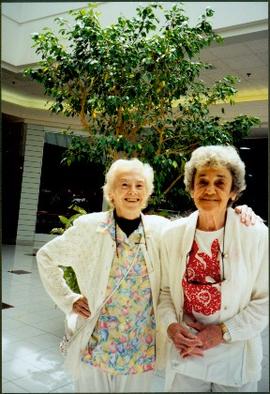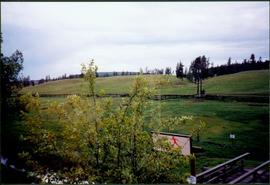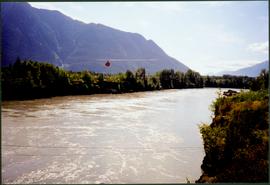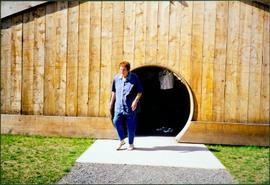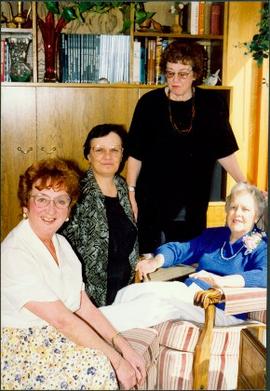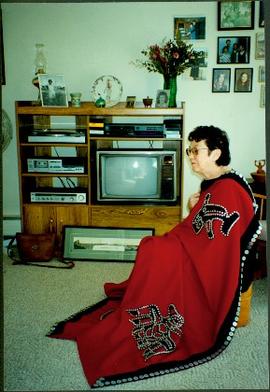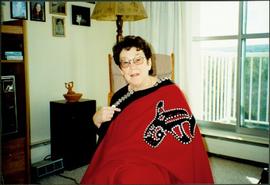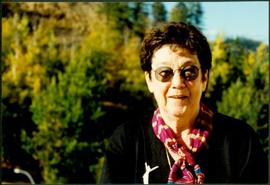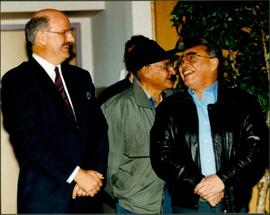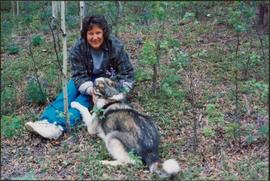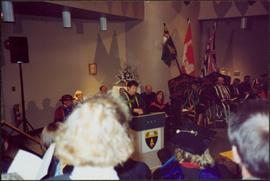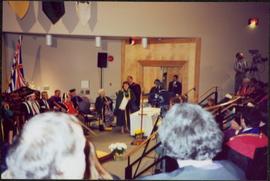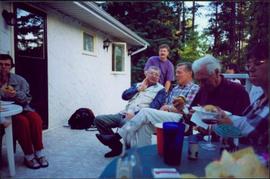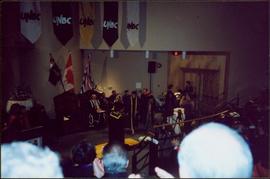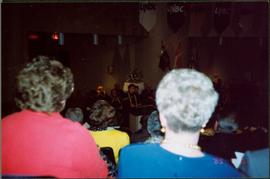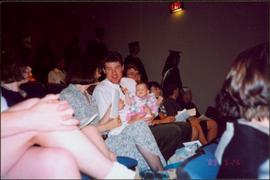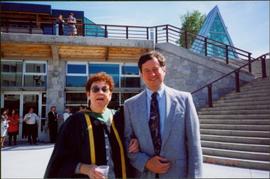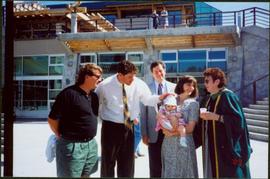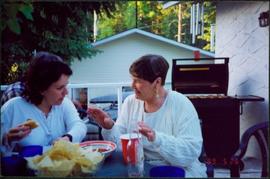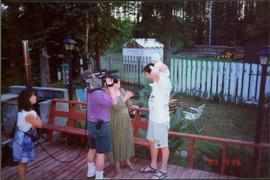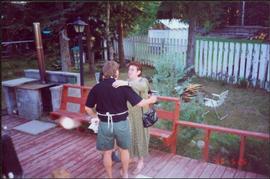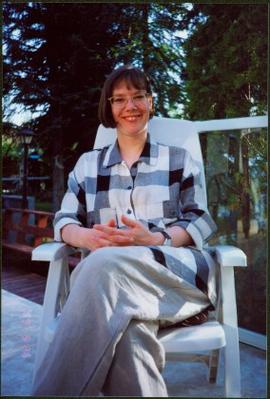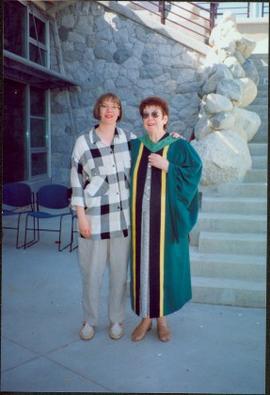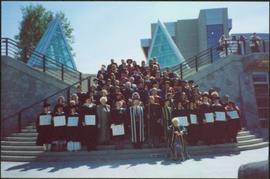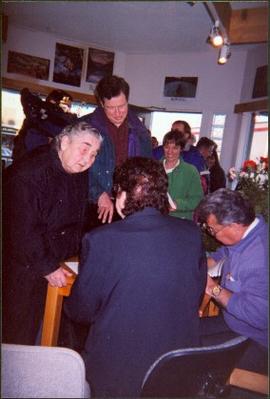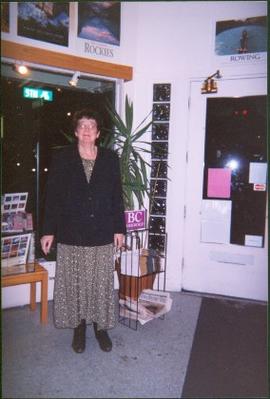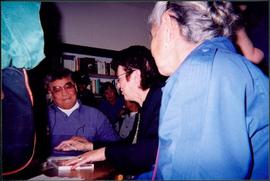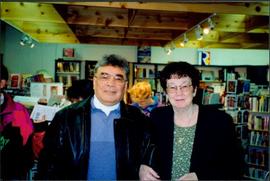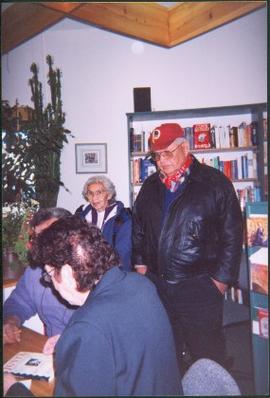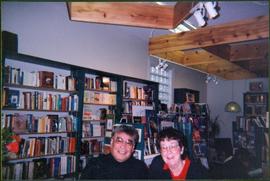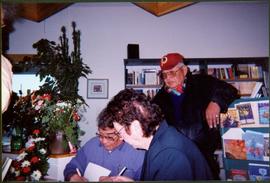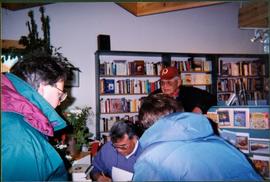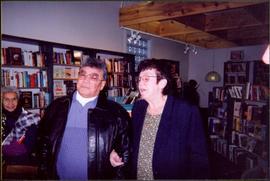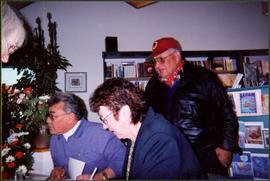Photograph depicts two unidentified woman standing in front of tall plant in mall. Photo believed to have been taken in Newton, B.C.
Photograph depicts landscape scene. Tree, bridge, and sign featuring cross country skier in foreground. Fence, hills, and forest in background.
Photograph depicts wide river with forest shores on either side. Power lines in foreground, mountain in background.
Photograph depicts Moran walking away from round entrance to long house, unidentified individual visible inside.
Photograph depicts Moran standing behind three seated women in unknown room. Plants and bookshelves in background.
Photograph depicts Moran seated in chair at unknown location. Red and black button blanket features traditional thunderbird and killer whale designs. Television against wall in background.
Photograph depicts Moran seated in chair at unknown location. Red and black button blanket features traditional thunderbird and killer whale designs. Television, armchair, and window visible in background.
Photograph depicts close view of Moran wearing black shirt and colourful scarf, forest visible in background.
Photograph depicts Justa Monk standing to right of Premier Harcourt in unknown room. John Alexis can be seen between them in background.
Photograph depicts Millard seated on forest floor, with husky in foreground.
Photograph depicts Moran wearing regalia and standing at podium while reading at the University of Northern British Columbia in Prince George, B.C. Group sits in foreground and background. Flags and speakers can be seen against far wall.
Photograph depicts Moran wearing regalia and holding an unidentified item in the Canfor lecture theater at the University of Northern British Columbia in Prince George, B.C. Group sits against wall in foreground and in theater seats in background. Flags and speakers can be seen against far wall. Cameras and photographers also visible in image.
Photograph depicts group of men and women eating on deck attached to unknown house. Photo believed to have been taken during event held to celebrate Bridget Moran receiving an Honourary Law Degree from the University of Northern British Columbia in Prince George, B.C.
Photograph depicts Moran and others in regalia in the Canfor Theatre at the University of Northern British Columbia in Prince George, B.C. Moran walks to podium, flags and camera equipment are also visible in auditorium. Audience sits in foreground. Accompanying note from Maureen Faulkner: "You are being summoned! You are very nervous here."
Photograph depicts Moran and others in regalia in the Canfor Theatre at the University of Northern British Columbia in Prince George, B.C. Moran stands in front at podium, flags against wall in background. Audience sits in foreground. Accompanying note from Maureen Faulkner: "You are giving the convocation address. Nicely done! It's wonderful to know you and your family. I'm proud of you." Photo taken on the day Bridget Moran received an Honourary Law Degree.
Photograph depicts men, women, and infant sitting in crowded Canfor Theatre at the University of Northern British Columbia in Prince George, B.C. Accompanying note from Maureen Faulkner: "Your family. now behind R [Roseanne Moran] + me. look on with pride & interest." Photo taken on the day Bridget Moran received an Honourary Law Degree.
Photograph depicts Moran wearing regalia, arms linked with Ramsey in Agora courtyard at the University of Northern British Columbia in Prince George, B.C. Unidentified individuals stand near Winter Garden in background. Accompanying note from Maureen Faulkner: "Your friend." Photo taken on the day Moran received an Honourary Law Degree.
Photograph depicts Moran wearing regalia, standing to right of family members in the Agora courtyard at the University of Northern British Columbia in Prince George, B.C. Sons Mike (wearing black) and Pat stand on left, and Paul Ramsey stands in center. Unidentified individuals stand near Winter Garden in background. Photo taken on the day Moran received an Honourary Law Degree.
Photograph depicts Maureen Faulkner seated to left of woman at table set with food and beverages on deck in backyard. Barbeque, trees and building visible in background. Photo taken on the day Bridget Moran received an Honourary Law Degree from the University of Northern British Columbia in Prince George, B.C.
Photograph depicts Moran standing between cameraman and son Pat (who holds infant) on deck in backyard. Trees, fence, and neighbouring yard in background. Accompanying note from Maureen Faulkner: "T.V. Camera & crew documents you, your life & family." Photo taken on the day Bridget Moran received an Honourary Law Degree from the University of Northern British Columbia in Prince George, B.C.
Photograph depicts Moran embracing son Mike on deck in backyard. Trees, fence, and neighbouring yard in background. Photo taken on the day Bridget Moran received an Honourary Law Degree from the University of Northern British Columbia in Prince George, B.C.
Photograph depicts Bridget Moran's daughter Roseanne sitting in patio chair on deck in backyard. Deck railing in midground, trees in background. Accompanying note from Maureen Faulkner: "Roseanne - elegant." Photo taken on the day Bridget Moran received an Honourary Law Degree from the University of Northern British Columbia in Prince George, B.C.
Photograph depicts Bridget wearing regalia while embracing Roseanne. Stone steps in background. The pair stands in the Agora courtyard at the University of Northern British Columbia in Prince George, B.C. Photo taken on the day Bridget Moran received an Honourary Law Degree.
Photograph depicts large group posed on ceremonial steps in Agora courtyard at the University of Northern British Columbia in Prince George, B.C. Most individuals in group wear regalia. Bridget Moran stands in the second row, sixth from right (wearing sunglasses). Photo taken on the day Moran received an Honourary Law Degree.
Photograph depicts Justa Monk and Bridget Moran seated at table, signing copies of 'Justa: a First Nations Leader'. The pair faces crowd standing in background. Windows and posters visible behind crowd.
Photograph depicts Moran standing in bookstore. Window, door, and plants in background. Photo taken at book signing event for Moran's 'Justa: a First Nations Leader'.
File consists of handwritten note from Roseanne Moran to her mother Bridget re: the "Justa" draft and an annotated draft of "Justa."
File consists of edited chapters two through six of "Justa."
Item is a audio interview recorded by Bridget Moran with Justa Monk.
Audiocassette Summary
00’ 05” Justa is talking about cutting wood for heat at home. He talks about wrecking his father’s axe. He continues to tell amusing stories about his childhood, which include his siblings and his father.
04’ 45” Moran asks Justa about how many employees he had when he was band manager. Justa talks about his work as band manager. They continue to talk about sawmills in the area. Justa discusses land rights as a result of the sawmills in their territory. Justa talks about tree farm licenses and the disputes between the band and the government. He talks about agreements the band has with Northwood Pulp and Timber Ltd.
16’ 35” Moran asks Justa about the note Theresa left him about being either a father or a band manager. They talk about this briefly.
18’ 23” Moran asks Justa about stories in his diary, such as trying to quit smoking. They talk about Justa becoming band leader. They continue to talk about Justa’s duties as general manager for the band and the politics surrounding the position.
25’ 14” Moran asks Justa about developing a school board for Tachie that is run by First Nations people. He wants to develop a proper curriculum that embraces the old way of life to maintain their culture.
30’ 40” Moran asks Justa why he stepped down as general manager for the band. Justa talks about someone else wanting the position. He also talks about the restraints on him. He talks about becoming tribal chief. He was given the mandate to deal with Kemano II, land claims, and developing forms of self-government.
41’ 15” Moran asks about the spread of AIDS in Tachie. Justa says, like cancer, it has spread because of stupidity. His people were healthy until the modernization of their society.
42’ 22” They return to discussing the opening of sawmills in the Tachie area, as well as tree licenses.
49’ 00” Moran asks Justa how many bands have dropped out of land claims issues. Ten remain, he tells her. They continue to discuss the issue of land claims.
50’ 47” Moran asks about when the tribal chiefs came together to have a common goal with regard to land claims. They continue to discuss land base, the progress of land claims, and the amount of people in each area. Justa talks about private companies entering their land and building private roads to log the area. They continue to talk about the politics of the position.
1:00’ 13” Moran asks Justa about his tribal chief position. He tells her it is a ‘twenty-four hour machine’ and to develop working relationships between the bands and the government, particularly with land claims and poverty issues. Justa continues to talk about his position.
1:09’ 11” Moran asks Justa which position he feels has helped his people the most. He tells her being band manager and tribal chief because he feels he has the right vision for his people that he can implement through clear direction and demanding certainty from the government, particularly with land claims. He talks about wanting to save the future of the nations and saving the river from the Kemano II Project. They continue to discuss the history of the Kemano II Project.
1:17’ 38” End of tape.
Photograph depicts Justa Monk and Bridget Moran seated at table, signing copies of 'Justa: a First Nations Leader'. Crowd stands gathered around.
File consists of handout invitations to the official book launch of Justa, Saturday Nov. 26 at Mosquito Books, Prince George, B.C.
File consists of a handwritten letter from Mayo Moran to her mother Bridget re: the "Justa" draft (April 6, 1994), an annotated draft of "Justa," "Land Claims" pamphlet produced by the Carrier Sekani Tribal Council, and "Fort St. James Forest District Recreation Map" produced by the Province of British Columbia, Ministry of Forests (Dec. 1991).
Item is a audio interview recorded by Bridget Moran with Justa Monk.
Audiocassette Summary
00’ 06” Justa is talking about the Kemano II Project and what he said in a meeting with the Ministers. He has asked them to stop the Project or they will face judicial review because they are basing the Project on a political basis, not a scientific basis. He says he feels he will win the case.
04’ 57” Moran tells Justa she is working on the chapter about when he kills his brother John. Moran asks Justa about what happened and he tells her all he remembers is when the cops arrested him. They continue to talk about what happened, though Justa’s memory is vague. Justa talks about his time in prison.
24’ 54” Moran asks Justa about when he moved to Fort St. James after he was released from prison. He moved to Dawson Creek after being picked arrested again.
27’ 58” Justa talks about moving back to Tachie, then going to work for BC Rail in 1970. At that time, he was hired as band manager.
28’ 50” They return to discussing the Kemano II Project.
32’ 20” Moran and Justa return to discussing the murder of his brother.
34’ 50” Moran and Justa talk about Brother Anderson, who worked at the residential school.
41’ 15” Moran talks to Justa about his brother Alec who passed away at a young age. The person who fell off a roof was a cousin.
42’ 30” Moran asks Justa about being left on Haldi Road when he was working at the rehabilitation camp. He talks about Haldi Camp and it was decent living conditions. There was no counselling offered.
47’ 57” Moran asks Justa if his troubles at that time were related to alcohol. He tells her that his fights were caused from drinking. He talks about his parents telling him they were worried about his drinking. He began to black out, but did not worry about it because he says he was young and did not pay attention.
49’ 55” After Justa left Dawson Creek, he returned to Tachie. Two weeks after he was home, Teddy was shot. They talk about the circumstances surrounding his death.
56’ 08” Moran asks Justa about his memories of Tachie when he started as a maintenance man in the 1970s. He says the roads were rough or hardly there. He talks about his job shovelling snow or pulling vehicles out of the mud. They talk about the Tachie community in the early 1970s. Justa talks about building the community up.
1: 08’00” Justa talks about his wedding to Theresa. Very few people attended the wedding. It took a long time for Justa’s family to recognize her as part of the family.
1: 12’ 54” Moran asks Justa about life in Tachie. Justa tells her things were done collectively, there was no division within in the community. He wishes the old way of life was still a part of the community. He talks about the love of ‘potlatch’ in the community. He talks about how the old way of life disappeared once the road was built.
1: 19’ 50” Moran asks Justa what he is working on. Justa says he is wrapping up the treaty process, budget proposals, and a couple other issues. He talks about Kemano II. He is serious about leaving his position because he has been neglecting his family. They continue to talk about the Kemano II Project.
1: 29’ 09” End of tape.
Item is a audio interview recorded by Bridget Moran with Justa Monk.
Audiocassette Summary
00’02” Justa is talking about the store in Tachie.
02’ 13” Moran asks Justa to clarify his different positions when working for the band, and when he served in those positions. He talks about the years he was band manager and tribal chief, and talks about these positions. He discusses the stress of the positions because of lack of funding.
16’ 29” Moran asks Justa about the different programs, such as water systems and education. Justa discusses getting the water system into Tachie. He discusses the details of trying to get the water system, particularly trying to get funding and getting the proper contractors. He talks about the stress of the position and how it affected his mind.
39’ 04” Justa talks about the differences between being a band manager and a tribal chief. He tells her there were no politics involved in being a band manager.
41’ 30” Moran asks Justa to draw her a map of Tachie and Sunnyside for the book, so she knows where everything can be found. Justa draws her a detailed map that includes the lake and the river.
52’ 34” Moran asks Justa about his week as a band manager and tribal chief, starting from Monday to Friday. He talks about his meetings involving contracts, social assistance, education, and other funding concerns. He reads from his diary to Moran.
1:02’ 55” Moran asks Justa about when Tachie received a telephone system. Justa talks about how he actually regrets getting a telephone and television system because of the loss of community.
1:08’ 55” Justa returns to talking about Kemano II.
1:14’ 59” Moran’s voice is muffled and incomprehensible.
1:16’ 35” Moran asks Justa for photographs for the book. Moran wants a subtitle for the book, so asks Justa for something in Carrier. Moran tells Justa that the CBC has asked why she is writing a book about him. They discuss the general details of the book.
1:26’ 17” End of tape.
Justa Monk and Bridget Moran stand in foreground. Unidentified individuals can be seen in bookstore in background. Bridget Moran published a book in 1994 entitled 'Justa: A First Nations Leader, Dakelhne Butsowhudilhzulh'un'.
Photograph depicts Justa Monk and Bridget Moran seated at table, signing copies of 'Justa: a First Nations Leader'. Plants, bookshelves, and two unidentified individuals in background.
Photograph depicts Justa Monk and Bridget Moran seated in bookstore, bookshelves in background.
Photograph depicts Justa Monk and Bridget Moran seated at table, signing copies of 'Justa: a First Nations Leader'. Plants, bookshelves, and unidentified man visible in background.
File consists of:
- Linda's correspondence and non-encouragement re: Justa (Aug. 9, 1994)
- Letter to Bridget Moran from Brian Lam, publisher Arsenal Pulp Press, Ltd. re: Justa edits (Aug. 11, 1994)
- Letter to Bridget Moran from Brian Lam, publisher Arsenal Pulp Press, Ltd. re: Justa edits (Sept. 20, 1994)
- Letter to Bridget Moran from Brian Lam, publisher Arsenal Pulp Press, Ltd. re: Justa edits (July 14, 1994)
- Linda's correspondence re: Justa (Sept. 5, 1994)
- Justa extra chapters and a note to Justa Monk regarding the reading of these chapters 16-21 from Bridget Moran.
File consists of edited chapters six through twelve of "Justa."
File consists of edited chapters thirteen through eighteen of "Justa."
File consists of an annotated transcript of interviews between Bridget Moran and Justa Monk.
Item is a audio interview recorded by Bridget Moran with Justa Monk.
Audiocassette Summary
00’ 01” Justa is talking about the Kemano II Project, which he states is a political issue, not an environmental one. He says the Project is a public issue now, not just a First Nations issue.
06’ 52” Moran asks Justa about when he was elected to tribal chief. He talks about the nominations process.
09’ 52” End of tape.
Item is a audio interview recorded by Bridget Moran with Justa Monk.
Audiocassette Summary
00’ 04” Moran is talking about book signings for Justa’s book.
00’ 27” Justa and Moran talk about board members for the Kemano II Project. They continue to talk about the Kemano II Project. Justa says the amount of pressure he is putting on the government, combined with public support, hopefully means Kemano II will be stopped. They continue to discuss the details and the politics surrounding the Project.
10’ 26” Moran asks Justa whether he was surprised or not when he lost the position of tribal chief at the last Assembly. He tells her he was not surprised. He talks about the first time he resigned from the position due to stress. He says the band knew he was tired, so did not want the position any longer. In a letter he wrote, he stated it was time for some new blood.
21’ 11” Moran asks Justa about his new position. He talks about being a contractor to Northwood Pulp and Timber where he liaisons between First Nations people and the company on employment concerns and tree sales. He talks about his position in more detail.
28’ 46” Moran asks Justa about how he feels about his life now. He tells her he feels good about what he has accomplished, but he needs a rest. He talks about his accomplishments throughout his career. He tells Moran he has no regrets about anything.
37’ 55” Moran asks Justa about his health issues and how he is feeling now.
38’ 57” End of tape.
File consists of one 5.25" floppy disk, containing the following files:
- “Dedicate”- Dedication
- “Eighteen”- Draft
- “Epilogue”- Draft
- “Foreword”- Author’s Foreword
- “I Refuse”- Letter to Brian at Arsenal Pulp Press re: Justa
- “Introduction”- Draft
- “I Refuse 2”- Letter to Brian at Arsenal Pulp Press re: Justa
- “I Refuse 3”- Letter to Brian at Arsenal Pulp Press re: Justa
- “Nineteen”- Draft
- “Seventeen”- Draft
- “Summary”- Summary of Justa
- “Thanks”- Author’s Acknowledgements
- “Twenty”- Draft
- “Two One”- Draft
File consists of a videocassette (VHS) recording of Mary John at Metlakatla in May 1994, originally filmed on a handheld camcorder on Video 8 cassette. Bridget noted in a later 1994 interview with Bob Harkins that this road trip was conducted for them to attend the basic education class at Metlakatla; this recording has also been reformatted on DVD.
Videocassette Summary
Context: Video-recording conducted by Bridget Moran with Mary John on their road trip to Metlakatla to visit the Elders Group there.
Highlights Include:
0’:05” Bridget Moran records on videotape Mary John in New Hazelton at the road side
1’00” Bridget Moran records on videotape Mary John in front of the totem poles in K’san ‘Old Hazelton’ and note they are heading by car to Prince Rupert
2’00”At Metlakatla Mary is shown eating fried dried seaweed in a hall in Metlakatla with a group of people
7’:35” Mary discusses working in the hospital and financially having a hard time as her husband was out of a job due to change in logging practices. He had a difficult time being at home and Mary sometimes had to walk to work to Vanderhoof, a distance 9+ miles from Stoney Creek. Talks about a time of having to walk to work on the ice and put bales of hay in her boots to walk on the ice
10’:35” Talks about the difficulties of working in the white world
11’:15” Talks about the time that her son made his First Communion; priest offered to buy lunch for all the children; Mary remembers having him ask if she and her son could come into the restaurant as normally they were not allowed to go to the restaurants
14’30” Sandra explains how they had decided to invite Mary to Metlakatla; she had read the Stoney Creek Woman book and wondered if Mary was still alive; she called the Band office in Vanderhoof and was connected with Mary’s niece who asks if she would come to Metlakatla. And then decided to invite Bridget as well.
18’37” Mary talks about the origin of certain Carrier place names for the various lakes in the Stoney Creek area and notes that many white people could not pronounce the names and so they became an anglicized version of native name. Explains the origin of the Bednesti Lake name
21’:55” Mary John explains about how liquor first coming into the territory and talks about how some of the men went on the train to join the war. She sings and drums a song called ‘Passenger Song’ and then explains the song
25’:43” Mary performs the ‘Four Winds’ song
26’:37” Mary talks about how the dancing had died out at Stoney Creek and c.1960 it was recommended that the dancing come back with a pageant to celebrate the 100th anniversary of missionaries arriving in their territory. The celebration was recorded on film. Talks about how dancing has been revived and now is taught to the children
30’30” Talks about the costumes made for the dancing. Talks about a moose hide she made for Eddie John
31’30” Bridget notes that Mary is now making a vest for Justa Monk who Bridget notes she has written a book about;
32:45” Bridget refers to the opening of UNBC and the coming of the Queen to open the University and how some native people in Prince George were against her opening UNBC
34’:40” Talks about the role of the Indian Agent historically
35’00” Talks about the role of policing in the native community and how to improve it
36’53” Bridget is recording Mary John outdoors at Lejac where they are looking at ruins of the old buildings. Mary points out the old Post Office building; Mary then shows the ruins of the old school and talks about segregation of the boys and girls at the school; she shows the play room of the old school; visits a cemetery and shows where Father Coccola is buried; then shows the buildings at Lejac old school buildings
Video temporarily stops
42’45” Shows Mary John back at her house in Stoney Creek
42’50” Bridget asks what is the most common question asked by people – of what do you want for your people – Mary states ‘hang on to culture and get an education”
43’40” Mary states that conditions have improved slightly [compared to 1976 at the time of Coreen Thomas’ inquest] but not to the level that she would like to see – as there are still alcohol, drug and unemployment problems
44’32” Mary notes that the preservation of the language has been ‘really good’ that the Elders are teaching other adults about their culture so that they can teach children; she notes that many Elders can speak Carrier really well – compared to the group noting at Metlakatla that not as many can speak their language.
46’00” Mary states there are many students at the [Yinka Dene] Language Institute; about 15-20 students
47’:24” Mary notes that ‘Potlatches are very important to our culture’ and that the Elders managed to save it
48’01” Mary refers to their road trip back from Metlakatla and their stop at Lejac. She talks about Lejac and how it is now destroyed – it would be better to preserve it and show what had happened there – Bridget compares it to the concentration camps in Germany and the preservation of those buildings to show the horrors of what went on there
49’13” Mary says she doesn’t dwell on the memories of LeJac – she had been there 72 years ago
50’00” Mary talks about the start up of the Potlatch House and the set up of a learning centre and the need to have it create work for the young people – Bridget notes that the potlatch house is now the centre of village activity
52’15” Bridget and Mary John reminisce about ’our’ book – and Bridget notes it was a ‘labour of love’ Mary notes that the book has made a difference – to treat First Nations people more like people – to show [others] [the impact] of racism
54’00” Bridget asks Mary to show the button blanket that Mary was given in Metlakatla and Bridget refers to the button blanket she was given as well. [The blanket is designed as a traditional Northwest Coast Button Blank; on the back of the blanket it is embroidered with beadwork in a circular pattern with the inscription ‘Keep the Circle Strong’ Bridget notes that the Elders there had a wonderful dinner for us as well.
54’58” Bridget videotapes Mary outside by the lake and she shows the outside of the log house which is the Potlatch House at Stoney Creek. She then shows the interior of the building which has photos of Elders on the wall.
Videotape ends
File consists of a Video 8 recording of Mary John in Metlakatla. : Bridget noted in a later 1994 interview with Bob Harkins that this road trip was conducted for Mary and her to attend the basic education class at Metlakatla. This recording has also been reformatted on DVD. This version of Mary John: Metlakatla is the original version filmed using a Video 8 videocassette formatted for hand-held camcorders. The version of Mary John: Metlakatla comprising 2008.3.1.202 is a master copy.
Videocassette Summary
Context: Video-recording conducted by Bridget Moran with Mary John on their road trip to Metlakatla to visit the Elders Group there.
Highlights Include:
0’:05” Bridget Moran records on videotape Mary John in New Hazelton at the road side
1’00” Bridget Moran records on videotape Mary John in front of the totem poles in K’san ‘Old Hazelton’ and note they are heading by car to Prince Rupert
2’00”At Metlakatla Mary is shown eating fried dried seaweed in a hall in Metlakatla with a group of people
7’:35” Mary discusses working in the hospital and financially having a hard time as her husband was out of a job due to change in logging practices. He had a difficult time being at home and Mary sometimes had to walk to work to Vanderhoof, a distance 9+ miles from Stoney Creek. Talks about a time of having to walk to work on the ice and put bales of hay in her boots to walk on the ice
10’:35” Talks about the difficulties of working in the white world
11’:15” Talks about the time that her son made his First Communion; priest offered to buy lunch for all the children; Mary remembers having him ask if she and her son could come into the restaurant as normally they were not allowed to go to the restaurants
14’30” Sandra explains how they had decided to invite Mary to Metlakatla; she had read the Stoney Creek Woman book and wondered if Mary was still alive; she called the Band office in Vanderhoof and was connected with Mary’s niece who asks if she would come to Metlakatla. And then decided to invite Bridget as well.
18’37” Mary talks about the origin of certain Carrier place names for the various lakes in the Stoney Creek area and notes that many white people could not pronounce the names and so they became an anglicized version of native name. Explains the origin of the Bednesti Lake name
21’:55” Mary John explains about how liquor first coming into the territory and talks about how some of the men went on the train to join the war. She sings and drums a song called ‘Passenger Song’ and then explains the song
25’:43” Mary performs the ‘Four Winds’ song
26’:37” Mary talks about how the dancing had died out at Stoney Creek and c.1960 it was recommended that the dancing come back with a pageant to celebrate the 100th anniversary of missionaries arriving in their territory. The celebration was recorded on film. Talks about how dancing has been revived and now is taught to the children
30’30” Talks about the costumes made for the dancing. Talks about a moose hide she made for Eddie John
31’30” Bridget notes that Mary is now making a vest for Justa Monk who Bridget notes she has written a book about;
32:45” Bridget refers to the opening of UNBC and the coming of the Queen to open the University and how some native people in Prince George were against her opening UNBC
34’:40” Talks about the role of the Indian Agent historically
35’00” Talks about the role of policing in the native community and how to improve it
36’53” Bridget is recording Mary John outdoors at Lejac where they are looking at ruins of the old buildings. Mary points out the old Post Office building; Mary then shows the ruins of the old school and talks about segregation of the boys and girls at the school; she shows the play room of the old school; visits a cemetery and shows where Father Coccola is buried; then shows the buildings at Lejac old school buildings
Video temporarily stops
42’45” Shows Mary John back at her house in Stoney Creek
42’50” Bridget asks what is the most common question asked by people – of what do you want for your people – Mary states ‘hang on to culture and get an education”
43’40” Mary states that conditions have improved slightly [compared to 1976 at the time of Coreen Thomas’ inquest] but not to the level that she would like to see – as there are still alcohol, drug and unemployment problems
44’32” Mary notes that the preservation of the language has been ‘really good’ that the Elders are teaching other adults about their culture so that they can teach children; she notes that many Elders can speak Carrier really well – compared to the group noting at Metlakatla that not as many can speak their language.
46’00” Mary states there are many students at the [Yinka Dene] Language Institute; about 15-20 students
47’:24” Mary notes that ‘Potlatches are very important to our culture’ and that the Elders managed to save it
48’01” Mary refers to their road trip back from Metlakatla and their stop at Lejac. She talks about Lejac and how it is now destroyed – it would be better to preserve it and show what had happened there – Bridget compares it to the concentration camps in Germany and the preservation of those buildings to show the horrors of what went on there
49’13” Mary says she doesn’t dwell on the memories of LeJac – she had been there 72 years ago
50’00” Mary talks about the start up of the Potlatch House and the set up of a learning centre and the need to have it create work for the young people – Bridget notes that the potlatch house is now the centre of village activity
52’15” Bridget and Mary John reminisce about ’our’ book – and Bridget notes it was a ‘labour of love’ Mary notes that the book has made a difference – to treat First Nations people more like people – to show [others] [the impact] of racism
54’00” Bridget asks Mary to show the button blanket that Mary was given in Metlakatla and Bridget refers to the button blanket she was given as well. [The blanket is designed as a traditional Northwest Coast Button Blank; on the back of the blanket it is embroidered with beadwork in a circular pattern with the inscription ‘Keep the Circle Strong’ Bridget notes that the Elders there had a wonderful dinner for us as well.
54’58” Bridget videotapes Mary outside by the lake and she shows the outside of the log house which is the Potlatch House at Stoney Creek. She then shows the interior of the building which has photos of Elders on the wall.
Videotape ends
Photograph depicts three unidentified individuals gathered around Justa Monk as he signs a copy of 'Justa: a First Nations Leader'. Plants and bookshelves in background.
Photograph depicts Justa Monk and Bridget Moran standing in bookstore. Unidentified woman and bookshelves in background.
Photograph depicts Justa Monk and Bridget Moran seated at table, signing copies of 'Justa: a First Nations Leader'. Plants, bookshelves, two unidentified individuals also visible in image.
